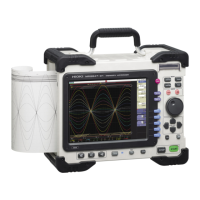Appendix 5 FFT Definitions
A27
Appendix
Linear Predictive Coding (LPC) ___________________________________
In the following figure, linear predictive coding is implemented by passing a sam-
ple of the input signal through the prediction filter while altering the filter so as to
minimize errors in the original signal.
Given a time-discrete signal {x
t
} (t is an integer) where the input signal is sam-
pled at interval ΔT, LPC analysis presumes the following relationship between
current sample value x
t
and the value of previous sample p.
However, is an uncorrelated random variable with average value 0 and the
dispersion .
Expression (15) shows how current sample value x
t
can be “linearly predicted”
from previous sample values. If the predicted value of x
t
is actually , expres-
sion (15) can be transformed as follows.
Here,
α
i
is called the linear predictor coefficient.
For LPC analysis, this coefficient is calculated using the Levinson-Durbin algo-
rithm, and a spectrum is obtained. In this instrument, the order of the coefficient
can be set from 2 to 64. Larger orders reveal fine spectral components, while
small orders reveal the overall spectrum shape.
Error Signal
Prediction Signal
Input Signal
Prediction Filter
tptpttt
xxxx
εααα
=+⋅⋅⋅+++
−−− 2211
t
p
i
itit
t
t
xxx
εαε
+−=+=
=
−
∧
1

